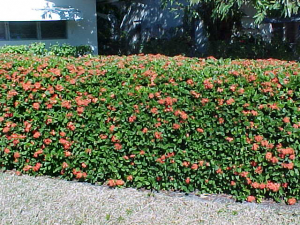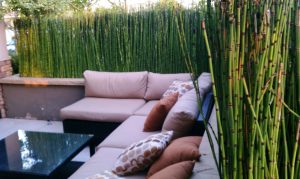by Ken Lain, the mountain gardener
As I noted in last week’s article, it has been 29 years since Lisa and I were married. It  was a joyful time for both of us, and our marriage has continued happily since. We were sweethearts through college and married upon graduating from Arizona State University.
was a joyful time for both of us, and our marriage has continued happily since. We were sweethearts through college and married upon graduating from Arizona State University.
Over the last two weeks nostalgia has carried me back to many happy memories. ,
Relax. I promise, no more old photos from our past. ~ Yes, that is the Prescott courthouse grass, 29 years ago!
![]()
It was Robert Frost that said, “Good fences make good neighbors”. In today’s fast-paced, noisy world we all need our privacy. Without it we become moody, perhaps even grumpy neighbors.
The most common fencing goals of the customers we’ve helped here at the garden center are privacy, security, and defining the actual line at a property’s edge. Whether to employ a privacy fence, a border planting, or a combination of the two, is a choice best made by the customer. Security, maintenance, and beauty, all must be taken into consideration. While plants hold the promise of beauty, usually more esthetically pleasing than a fence, nothing beats proper fencing for security from undesirable people and/or critters.
Sometimes it is enough to simply define a line of demarcation along the boundary so it’s always clear where your land leaves off and your neighbor’s begins. If that’s the objective, there are plants that effectively discourage trespassers.
Before landscaping property lines, always make sure you know precisely where the boundary lies, if unsure, hire a surveyor. While you’re at it, research the possible existence of easements. And if you decide on a fence, check to see if you need a fencing permit. Much bickering and deputes can be avoided by taking these precautionary steps.
My new book “The Secret Garden: Plants as a Natural Privacy Screen” goes into great detail on the subject. This week’s column is a synopsis of the outline used for the book. Feel free to download it for your convenience.
Fast Growing Shrubs for Privacy – Most gardeners who are landscaping to achieve privacy are in a hurry for that screen. This often is the case if next-door construction just broke ground, or the neighbor just parked that class-A motor home right at the property’s edge. Either way, you need to screen fast, right? Here’s the local Top 10 Plant List that will be of help.
More than Greens – Evergreen shrubs play a critical role at a landscape’s property lines. Evergreens provide foliage to admire all year long. They also provide year-round privacy. Evergreen doesn’t mean you are limited to the color green. Many evergreens are available in shades of gold, silver, cream, yellow, and blue. Our native Arizona cypress is a good example of a fast growing native that grows in colors of blue that border on hues of silver, and it is hardy!
Mix and Match Evergreens with Bloomers – For a more natural look I encourage planting evergreens and tall bloomers together. The combination creates the feel of a ‘Secret Garden’. The trick is to grow enough evergreens to block prying eyes, while injecting enough flowering shrubs to keep your own eyes constantly stimulated. An underplanting of blooming perennials really creates a feast for the senses with a lot of WOW!.
The list above is a good source of suitable plants to mix and match.

Garden Elegance through Tall Grasses – Grasses often are overlooked as a privacy screen. Throughout the mountains of Arizona there are several grasses that grow very well. Pampas grass is the first to come to mind, but there are many other choices. Consider our native bear grass, maiden grass, deer grass, and zebra grass. Each grows fast and fills in quickly with beautiful plumes from autumn through winter. Also look closely at native rabbit bush, staghorn sumac, and Apache plume as companion plants to grasses. They look great, are easy to grow, animal resistive, and all are care free once they have fully rooted into the landscape.
Clumping Bamboo is also a member of the grass family, several varieties of which grow well in the mountains of Arizona.

Deter Trespassers – A hedge of Oregon Grape Holly isn’t likely to keep a serious robber off your property. But the barbed leaves on this chest high native aren’t exactly comfortable to brush up against. The discomfort level should be sufficient to turn away all but the most determined would-be trespassers.
Taller roses and old fashioned pyracantha are two plants that discourage unwanted visitors. The blooms are beautiful, but the stems are covered in vicious thorns. Birds will love you for either of these choices, as they offer safe nesting sites and food sources.
Best Plants for the Job – Some plants are better than others in your garden. Before you visit the garden center measure the amount of sun or shade your boundary will have. Does the soil drain, or is it a heavy clay? Will there be serious threats from deer or javalina? Do you live on top of a rock pile? How windy will it be? Not all plants are created equal but there are some that will fit your circumstances. Using the answers to these basic questions helps us to help you design the perfect border planting.
Plant a Hedge – Technically, hedges are plants grown tightly together and trimmed into a living fence. Properly manicured, they form a partition that is as close to being a “wall” as plants possibly can be.
We curated a block of tall evergreens here at Watters that grow into head high fences and like to be trimmed and pruned. In fact, the more you trim these plants, the thicker they become. Visit us and ask for a personal tour of good fence plants and more details on the best plants for your hedge needs.
How to Measure – It’s a simple task to determine the number of plants needed to create a hedge. Look on the grower’s tag for the mature width of the plant. Divide that number by 2 for the recommended spacing between each plant. This formula ensures fast growth with an overlapping branch structure that is thick, secure, and perfect for hedging.
Deflect Annoying Wind – Trees are used at a property’s edge for many reasons. Not only can trees offer privacy, they also break the assault of strong winds to make living on the back patio bearable. Large evergreens like Colorado spruce, Deador cedar, and Arizona cypress are first to be considered, but this is also the place to plant a single row orchard with grape arbors between each tree. This design will give you grapes to enjoy, define your property lines, reduce prying eyes, and cut pesky wind.
Until next week, I’ll see you here at Watters Garden Center.
Ken Lain can be found throughout the week at Watters Garden Center, 1815 W. Iron Springs Rd in Prescott, or contacted through his web site at WattersGardenCenter.com or FB.com/WattersGardenCenter .

